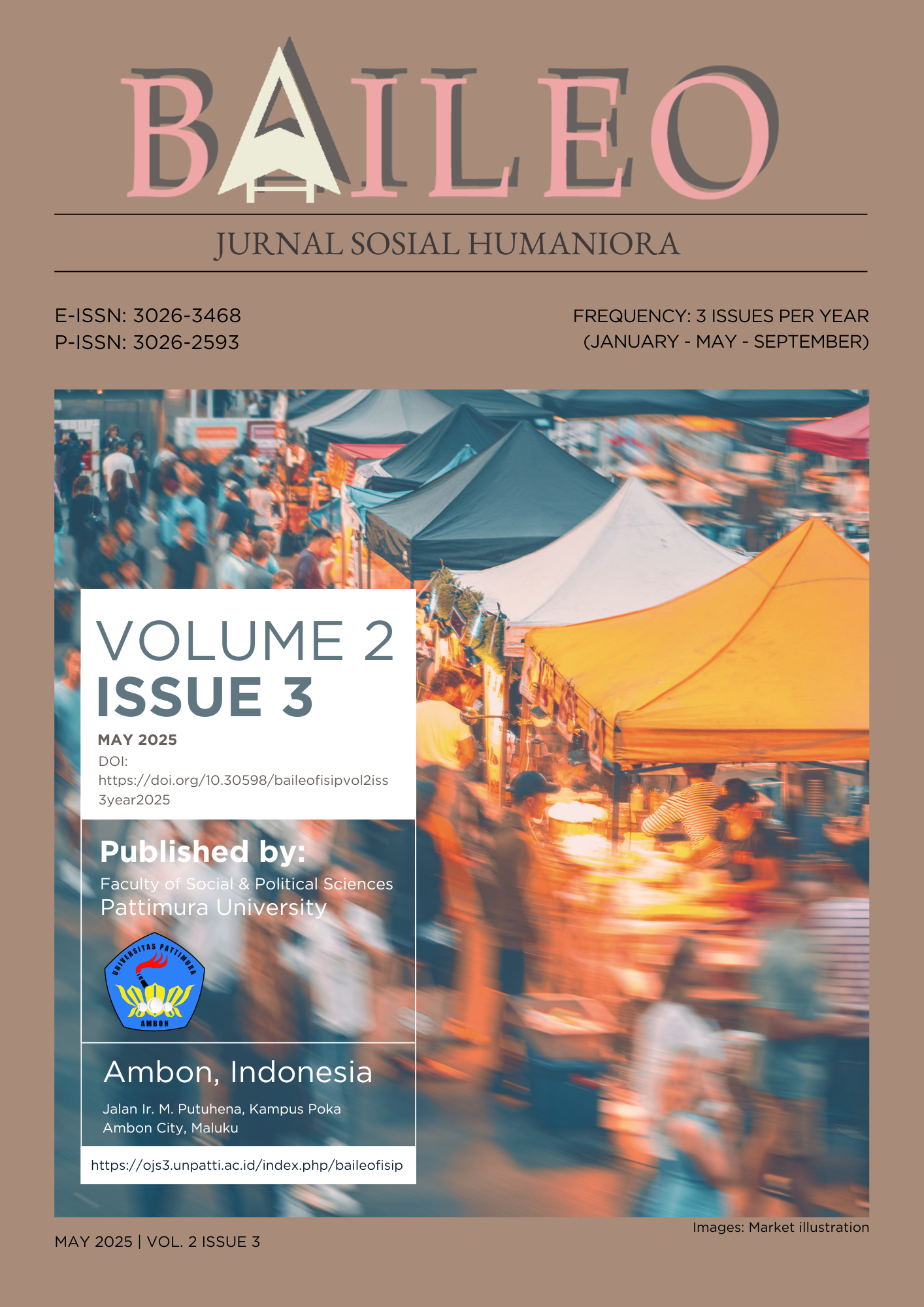Crisis, Identity, and Intoxication: Youth Drug Abuse and Socio-Economic Marginalization in Post-2000s Zimbabwe
Abstract
Drug and substance abuse among Zimbabwean youth in the post-2000 era has reached an alarming crisis level. This study aims to examine emerging trends in substance abuse practices among young people and to evaluate the effectiveness of existing intervention measures. Using a documentary survey method that draws on policy reports, media sources, and public records, the study investigates the strong link between acute socio-economic marginalization and the rise of increasingly creative yet hazardous substance consumption practices. Key findings indicate that while cannabis remains the most commonly abused substance, new and unconventional patterns have emerged. These include the misuse of prescription drugs, consumption of home-brewed intoxicants, transfusion of drug users’ blood, ingestion of drug-laced foods, and even the intake of sodium polyacrylate extracted from boiled baby diapers. The study highlights poverty, structural unemployment, and weak border surveillance as major driving forces. Despite various efforts by government authorities and law enforcement, current policy responses appear inadequate in addressing the evolving dynamics of the problem. The novelty of this study lies in its documentation of underreported forms of substance use and its analysis of how these practices relate to youth identity formation in the context of prolonged crisis. The study recommends an interdisciplinary and participatory approach to social policy, one that moves beyond punitive measures to include social rehabilitation, inclusive economic development, and the strengthening of positive youth identities. This research contributes to the broader field of social sciences and humanities, particularly in understanding the intersections of crisis, identity, and deviance within the Global South.
Downloads
References
Alacovska, A., Bucher, E., & Fieseler, C. (2025). Multimodal identity work: The power of visual images for identity construction in the gig economy. Human Relations. https://doi.org/10.1177/00187267241304591
Azad, A. H., Khan, S. A., Ali, I., Shafi, H., Khan, N. A., & Umar, S. A. (2022). Experience of psychologists in the delivery of cognitive behaviour therapy in a non-western culture for treatment of substance abuse: a qualitative study. International Journal of Mental Health Systems, 16(1), 55. https://doi.org/10.1186/s13033-022-00566-3
Banda Chitsamatanga, B., & and Malinga, W. (2021). ‘A tale of two paradoxes in response to COVID-19’: Public health system and socio-economic implications of the pandemic in South Africa and Zimbabwe. Cogent Social Sciences, 7(1), 1869368. https://doi.org/10.1080/23311886.2020.1869368
Bhatti, S. H., Irshad, R., Shehzad, N., & Santoro, G. (2023). Exploring the mediating role of social capital and pro-social motivation in the relationship between CSR and creative deviance. Journal of Intellectual Capital, 24(5), 1206–1226. https://doi.org/10.1108/JIC-06-2022-0129
Bird, L., Kane, M., Eligh, J., & Tagziria, L. (2024). Diffusion, diversion, displacement–but not disruption.
Boromisza-Habashi, D. (2023). Tracking the transmission of culture: a cultural discourse analysis of narratives of circulation in the US undergraduate public speaking course. Journal of Multicultural Discourses, 18(4), 243–261. https://doi.org/10.1080/17447143.2024.2353018
Castaldelli-Maia, J. M. (2023). Addiction Medicine or Addiction Psychiatry? International Review of Psychiatry, 35(5–6), 363–366. https://doi.org/10.1080/09540261.2023.2285938
Charzyńska, E., Sitko-Dominik, M., Wysocka, E., & Olszanecka-Marmola, A. (2021). Exploring the Roles of Daily Spiritual Experiences, Self-Efficacy, and Gender in Shopping Addiction: A Moderated Mediation Model. Religions, 12(5), 355. https://doi.org/10.3390/rel12050355
Chidora, T. (2024). Aestheticising Vulgarity and Marginality: Zimdancehall as a Subcultural Revolution BT - The Zimdancehall Revolution: Critical Perspectives (T. Chidora, D. Rumbidzai Tivenga, & E. Chitando (eds.); pp. 27–57). Springer Nature Switzerland. https://doi.org/10.1007/978-3-031-41854-9_2
Chipenda, C., & Cochrane, L. (2024). Out of school children in the context of new policy trajectories and interlocking crises in Zimbabwe: a transformative social policy perspective. SN Social Sciences, 4(7), 131. https://doi.org/10.1007/s43545-024-00938-1
Douglass, C. H., Karen, B., Donya, E., Danielle, H., Margaret E., H., & and Lim, M. S. C. (2024). “You have to drink with a little bit of shame”: Alcohol and other drug use among young people from migrant and ethnic minority backgrounds in Melbourne, Australia. Journal of Ethnicity in Substance Abuse, 23(2), 340–364. https://doi.org/10.1080/15332640.2022.2091703
Felker-Kantor, M. (2023). Arresting the Demand for Drugs: DARE and the School–Police Nexus in Los Angeles. Journal of Urban History, 49(5), 1108–1129. https://doi.org/10.1177/00961442221142062
Geldermann, A., Thomaschewski, R., Bertram, C., Woopen, C., & Jünger, S. (2024). Pervasiveness of health information in everyday life in Germany: insights from a photo-elicitation diary study on implicit health knowledge using the documentary method. Journal of Public Health. https://doi.org/10.1007/s10389-024-02209-y
Gukurume, S. (2025). Singing truth to power: youth existential struggles and popular music in Zimbabwe. Canadian Journal of African Studies / Revue Canadienne Des Études Africaines, 59(1), 149–173. https://doi.org/10.1080/00083968.2024.2439477
Höglund, H., & Rørbech, H. (2021). Performative spaces: Negotiations in the literature classroom. L1-Educational Studies in Language and Literature, 21, 1–23.
Lim, W. M. (2024). What Is Qualitative Research? An Overview and Guidelines. Australasian Marketing Journal. https://doi.org/10.1177/14413582241264619
Liu, F., & Zhou, K. (2021). Idiosyncratic deals and creative deviance: the mediating role of psychological entitlement. R&D Management, 51(5), 433–446. https://doi.org/10.1111/radm.12430
Liu, Z., Pan, X., & Zhu, T. (2021). Status-striving orientation, creative deviance engagement and employee creativity: perspective of structural strain. Chinese Management Studies, 15(4), 821–842. https://doi.org/10.1108/CMS-09-2020-0413
Mahuni, K., Zivanomoyo, J., Siyakiya, P., & Mutsvangwa, S. (2025a). Early Years of Post-independence Zimbabwe BT - Zimbabwe’s Economy: Four Decades in Perspective (1980-2020) (K. Mahuni, J. Zivanomoyo, P. Siyakiya, & S. Mutsvangwa (eds.); pp. 19–53). Springer Nature Switzerland. https://doi.org/10.1007/978-3-031-81588-1_2
Mahuni, K., Zivanomoyo, J., Siyakiya, P., & Mutsvangwa, S. (2025b). ‘Jewel of Africa’ Peeled: Four Blunders Over the Four Decades BT - Zimbabwe’s Economy: Four Decades in Perspective (1980-2020) (K. Mahuni, J. Zivanomoyo, P. Siyakiya, & S. Mutsvangwa (eds.); pp. 123–155). Springer Nature Switzerland. https://doi.org/10.1007/978-3-031-81588-1_6
Mahuni, K., Zivanomoyo, J., Siyakiya, P., & Mutsvangwa, S. (2025c). Making or Breaking Zimbabwe: 1987–2020 Issues BT - Zimbabwe’s Economy: Four Decades in Perspective (1980-2020) (K. Mahuni, J. Zivanomoyo, P. Siyakiya, & S. Mutsvangwa (eds.); pp. 95–120). Springer Nature Switzerland. https://doi.org/10.1007/978-3-031-81588-1_5
Makwanise, N. (2023). The Challenges of Fighting Drug Abuse Among the Youth in Zimbabwe. GNOSI: An Interdisciplinary Journal of Human Theory and Praxis, 6(2 SE-), 52–62. http://gnosijournal.com/index.php/gnosi/article/view/233
Mardani, M., Alipour, F., Rafiey, H., Fallahi-Khoshknab, M., & Arshi, M. (2023). Challenges in addiction-affected families: a systematic review of qualitative studies. BMC Psychiatry, 23(1), 439. https://doi.org/10.1186/s12888-023-04927-1
Margies, N. (2024). Making Sense of Change: Emotive-Cognitive Reframing of Young People in Post-crisis Spain. Cultural Sociology, 18(2), 238–257. https://doi.org/10.1177/17499755241234701
Masunungure, E. V, Moyo-Nyede, S., & Muruvi, M. T. (2025). Zimbabweans say drug and substance abuse is rampant, see it as a society-wide challenge.
Mateveke, P. (2022). Zimbabwean Popular Cultural Expressions of Alternative Sexual Identities. Journal of African Cultural Studies, 34(1), 32–47. https://doi.org/10.1080/13696815.2021.2020086
Mavima, S. (2024). Zimdancehall vs. The State: An Interrogation of the Genre as a Response to Socio-Political Crises in Zimbabwe BT - The Zimdancehall Revolution: Critical Perspectives (T. Chidora, D. Rumbidzai Tivenga, & E. Chitando (eds.); pp. 83–117). Springer Nature Switzerland. https://doi.org/10.1007/978-3-031-41854-9_4
Mhonyera, G., Stein, M., & and Meyer, D. F. (2023). Measuring the pass-through effect of global food price volatility and South Africa’s CPI on the headline inflation of Zimbabwe. Cogent Food & Agriculture, 9(1), 2212458. https://doi.org/10.1080/23311932.2023.2212458
Mkwananzi, F., F. Melis, C., & and Marovah, T. (2023). Transformative youth development through heritage projects: connecting political, creative, and cultural capabilities. International Journal of Heritage Studies, 29(6), 581–597. https://doi.org/10.1080/13527258.2023.2209058
Mkwananzi, W. F., Firdevs Melis, C., & and Marovah, T. (2021). Participatory art for navigating political capabilities and aspirations among rural youth in Zimbabwe. Third World Quarterly, 42(12), 2863–2882. https://doi.org/10.1080/01436597.2021.1977620
Moyo, I. (2023). Zimbabwe’s unemployed youth: On waithustlinghood, struggle for survival and political activism. Social Sciences & Humanities Open, 8(1), 100535. https://doi.org/https://doi.org/10.1016/j.ssaho.2023.100535
Mugari, I. (2024). The Emerging Trends and Response to Drug and Substance Abuse among the Youth in Zimbabwe. Social Sciences, 13(9), 469. https://doi.org/10.3390/socsci13090469
Mugari, I., & Bushu, R. (2024). Causes and Effects of Psychoactive Substance Abuse Among the Youth in Zimbabwe: The Case of Makokoba High Density Suburb, Bulawayo. Societies, 14(12), 262. https://doi.org/10.3390/soc14120262
Mukwara, P. (2024). Street theatre in Zimbabwe: a history of connection, disconnection, and reconnection. African Identities, 15(1), 1–12. https://doi.org/10.1080/14725843.2024.2324107
Museza, N. A., & Mazambani, G. T. (2023). Developing a Predictive Machine Learning Model to Determine the Likelihood of Readmission of Substance Abuse Patients in Zimbabwe. 2023 2nd Zimbabwe Conference of Information and Communication Technologies (ZCICT), 1–11. https://doi.org/10.1109/ZCICT59466.2023.10528432
Muyambo, T., & Sithole, E. (2021). ‘Identity Under Siege?’: The Making and Unmaking of Ndau Identity in Zimbabwe. Indilinga African Journal of Indigenous Knowledge Systems, 20(2), 221–241.
Muzuva, P., Gwiza, A., & Mudangwe, P. (2024). The Emerging War On Drug And Substance Abuse The Case Of Harare Central Business District, Zimbabwe. Ngenani: The Zimbabwe Ezekiel Guti Journal of Community Engagement and Societal Transformations, 59–74. https://doi.org/10.71458/dzyz3f54
Naeem, M., Ozuem, W., Howell, K., & Ranfagni, S. (2023). A Step-by-Step Process of Thematic Analysis to Develop a Conceptual Model in Qualitative Research. International Journal of Qualitative Methods, 22. https://doi.org/10.1177/16094069231205789
Naeem, M., Ozuem, W., Howell, K., & Ranfagni, S. (2024). Demystification and Actualisation of Data Saturation in Qualitative Research Through Thematic Analysis. International Journal of Qualitative Methods, 23. https://doi.org/10.1177/16094069241229777
Ray, L. A., & Grodin, E. N. (2021). Clinical Neuroscience of Addiction: What Clinical Psychologists Need to Know and Why. Annual Review of Clinical Psychology, 17(1), 465–493. https://doi.org/10.1146/annurev-clinpsy-081219-114309
Simha, A., Ahmed, S., Prasad, R., Dinesh, A. S., Kandasamy, A., & Rao, N. P. (2022). Effect of national cultural dimensions and consumption rates on stigma toward alcohol and substance use disorders. International Journal of Social Psychiatry, 68(7), 1411–1417. https://doi.org/10.1177/00207640211028611
Stanton, D. L., Makin, D., Stohr, M., Lovrich, N. P., Willits, D., Hemmens, C., Meize, M., Bowers, O., & Snyder, J. (2022). Law Enforcement Perceptions of Cannabis Legalization Effects on Policing: Challenges of Major Policy Change Implementation at the Street Level. Contemporary Drug Problems, 49(1), 20–45. https://doi.org/10.1177/00914509211053660
Van Milders, L. (2021). Precarity/Coloniality. Theory & Event, 24(4), 1068–1089. https://doi.org/10.1353/tae.2021.0059
Vides, B., Jennifer, M., Emily E., E., David, M., Shantel, C., Brett A., L., & and Goggin, R. (2022). The Trauma Resilient Communities (TRC) Model: A Theoretical Framework for Disrupting Structural Violence and Healing Communities. Journal of Aggression, Maltreatment & Trauma, 31(8), 1052–1070. https://doi.org/10.1080/10926771.2022.2112344
Copyright (c) 2025 Ruvimbo Nyatsanza, Farai Tendai Nyoni, Takudzwa Chiremba

This work is licensed under a Creative Commons Attribution 4.0 International License.




